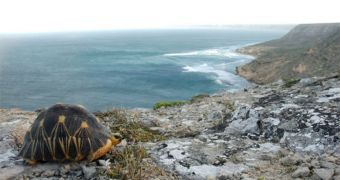According to a new scientific survey from the Turtle Survival Alliance (TSA) and the Wildlife Conservation Society (WCS), it would appear that the radiated tortoise (Geochelone radiata) is rapidly approaching extinction. The animal, which is endemic to Madagascar, the large island on the eastern coast of Africa, is currently under threat from excessive poaching. Illegal traders also capture the creatures to sell them as pets to the highest bidders, the report uncovered.
This particular tortoise species can be recognized by the fact that it carries a pattern of brilliant yellow stars on its shell. It is currently estimated that, within less than two decades, all members of the species could die out, unless drastic protection measures are implemented. The thing is, experts say, that the sparser a species gets, the more interest it elicits from illegal traders and other individuals. This makes protecting the tortoises very difficult. Conservation programs need to be set up in a way that allows for the drastic prosecution of people caught damaging the remaining populations.
The Smithsonian National Zoo graciously refers to G. radiata as being the most beautiful tortoise in the world today. The animal has a length of 41 centimeters from one end of its shell to the other, and can grow to reach a weight of 16 kilograms, or about 35 pounds. They can be found mostly in the southern parts of Madagascar, inside spiny forests. Once, they were abundant in the region, but the new survey has uncovered far less individuals than expected. The team states that poachers ferried entire trucks filled with tortoises to meat markets around, so as to fuel demand.
At one point, millions of tortoises could be found in Madagascar. Now, their initial habitat is almost fully wiped out, the survey discovered. “The rate of hunting of radiated tortoises is similar to the hunting pressure on American bison during the early 19th century, where they were nearly hunted to extinction when they once numbered in the tens of millions,” explains the WCS Species Program turtle conservation coordinator Brian D. Horne, quoted by LiveScience.

 14 DAY TRIAL //
14 DAY TRIAL //